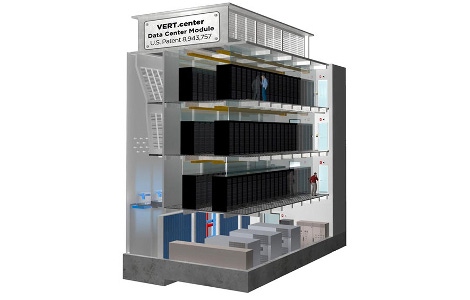Startup Patents Multi-Story Modular Data Center Design
Vert.com’s design inspired by Quebec’s cylindrical supercomputer data center
April 30, 2015

Quebec-based Vert.com has secured a U.S. patent for a multi-story modular data center design it hopes will appeal to companies needing high-density data centers in places with limited available real estate.
The startup plans to make money by licensing the design to others and claims that there’s currently interest from an unnamed New York financial services firm looking to build a data center inside a high rise, according to a recent report by 451 Research analyst Daniel Bizo. Patent in hand (secured in February), the company is now on the hunt for a partner that will help it take the design to market.
Marc Parizeau, Vert.com CTO and co-founder, was behind the supercomputer data center built inside a cylindrical silo that used to house a particle accelerator at the Laval University in Quebec City. Vert.com's patented data center design, called Vert.Center, was inspired by the work Parizeau and his team did at Laval, according to Bizo.
With total footprint of 1,200 square feet, the bottom floor of a single Vert.Center module houses all the electrical and mechanical infrastructure. It can be scaled simply by adding more prefabricated modules.
There can be from one to four IT floors, depending on the customer’s needs. The standard design can support up to 120 24-inch IT racks and back 1.2 megawatts of critical load.
Relying on a multi-mode economizer for cooling, it pushes cold air from the bottom infrastructure floor onto IT floors above through vertical plenums the floors share. Exhaust air is pushed into a chamber at the top, where it can be recirculated as is, mixed with outside air and recirculated, or ejected all together. The cooling system can switch between a combination of chilled water and outside air or relying on either one exclusively, depending on the weather outside.
Vert.com isn’t the only startup trying to carve out a niche for high-density data center deployments in urban areas. A startup called Vapor IO came out of stealth earlier this year with (coincidentally) a cylindrical data center pod design meant for small-footprint high-density IT deployments.
Vapor IO’s Vapor Chamber is not a building, however. It is a group of wedge-shaped racks arranged into a cylinder, with a chamber in the center serving the function of a cold aisle in a traditional data center layout.
While in rural areas the cost of real estate is an almost negligible portion of total data center cost, space in densely populated metros comes at a high premium. Demand for data center capacity in those areas, however, is high, driven by the need to serve web content and provide other web services to customers who live and work in those areas faster.
In the financial services sector, data center location decisions are also driven by physical proximity to electronic trading engines. Every extra millisecond of latency is a competitive disadvantage in that space.
As Bizo pointed out in his report, Vert.com isn’t the only company with a vertically-stacked data center design concept. From well-known companies like Schneider Electric to small shops like Germany’s e3 computing or U.K.’s Gardner DC Solutions, there are numerous options for users looking to stack a lot of data center per square foot of expensive urban real estate.
More details about the Vert.Center data center design on the company's website.
This isn't the only modular data center patent issued recently. Just this month we covered announcement by Rio de Janeiro-based SmartCube of a patent for its modular data center design.
About the Author(s)
You May Also Like



.jpg?width=700&auto=webp&quality=80&disable=upscale)



